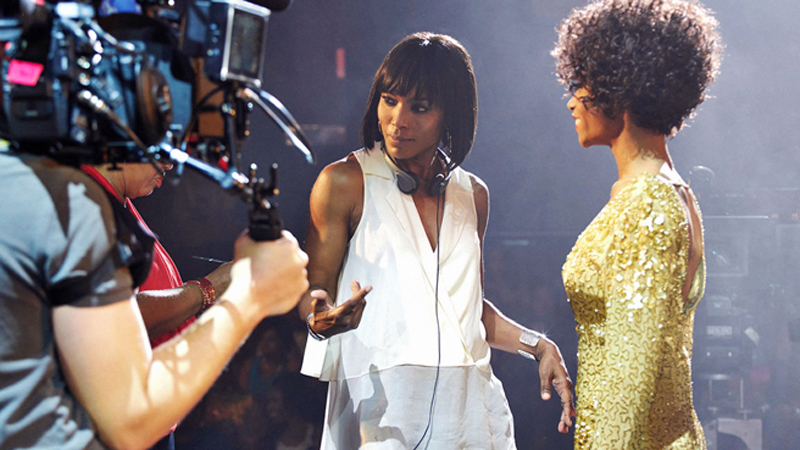
Amanda N’Duka | Deadline Hollywood
Whatever take one might have on Lifetime’s biopic Whitney, it is safe to say that it had an impact on people, which was quite evident at the Awardsline Emmy screening last night at the Landmark Theatre on Pico Blvd. The film marks the directorial debut of Oscar and Emmy-nominated actress Angela Bassett, and uncovers the volatile and infamous relationship between the platinum-selling singer and her then husband, pop R&B star Bobby Brown. During a 45-minute Q&A, moderated by Deadline’s Anthony D’Alessandro, Bassett and stars Yaya DaCosta (Whitney Houston), and Arlen Escarpeta (Bobby Brown) provided insight on how they tackled the controversial project. The film aired on Lifetime on January 17 and drew a record 4.5M viewers, the best for the network since the January 18, 2014 telecast of Flowers In The Attic.
As an actress who also portrayed a legendary R&B diva on screen — Tina Turner in 1993’s What’s Love Got to Do With It, Bassett was well acquainted with the demands that such a role brings, particularly for a young actress. It’s what made Bassett stand out behind the camera according to DaCosta and Escarpeta. Bassett wasn’t just shouting out myriad directives, rather she was a performer’s director, easily sympathizing with her leads’ emotional process and fostering a collaborative atmosphere. DaCosta recalled that after shooting a take where Whitney is emoting during a post miscarriage scene, Bassett gave the actress a four word direction which opened her eyes and heightened the dramatic intensity: “Baby dead, baby dying and it was a magic moment.”
Aside from playing Turner, what also made Bassett right for the directing job of Whitney was the fact that she actually knew and worked with the actress on the 1995 hit film Waiting To Exhale ($81.5M) — which in its day was a breakthrough for female ensemble features well before The First Wives Clubs, Sex And The City and Bridesmaids (Bassett also told Deadline following the screening that a sequel to the hit film, which was in talks for some time when Houston was alive, isn’t bound to happen).
Bassett’s memory of Houston on set was that she was “warm, charming and easy…regal and regular,” which helped inform her direction of Whitney.
In regards to why Whitney solely centered on Houston’s marriage, Bassett exclaimed that Bobby Brown “was the man that she fell in love with. He understood her…They understood each other. They were more alike then we could imagine.”
For years the media painted Brown as the bad boy, as the guy who lead Houston down a reckless path. However, the film shows a gentle side of the R&B rapper; that Houston was already self- destructive with cocaine before she even married Brown. Escarpeta admitted that initially he did have his preconceived notions on the man who everyone believed to be responsible for the downfall of Houston. But after researching the character, Escarpeta said “what was evident and clear was there was a love story “ and that brought out the more humane side of Brown. Rather then playing out how society perceived Bobby Brown, the actor felt that it was important “to get deeper and find out what was underneath that [bad boy persona] and what might have been happening behind the scenes.” He was “very respectable… and just very charming… and I was taken aback because he’s so different” Bassett mentioned that Escarpeta naturally possessed the sincerity she remembered in Brown. During Waiting for Exhale, he would sit on set, beaming at his wife’s success.
DaCosta, who nails the diva’s physical spirit in her poses and poises, expounded on her process, “I felt this pull, almost this duty to spend some time with her [Houston].” In her preparation, DaCosta pulled from the avenues that were available to her during that period. She focused on Houston’s public images, gathering pieces from interviews, videos, and some written work. And of course, Bassett was a go-to resource. Even though Houston bathed in the limelight, Bassett believed that “at her core, she was that church girl, that tomboy, that little sister with the big brothers.”
